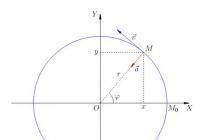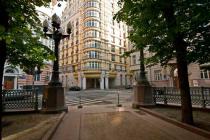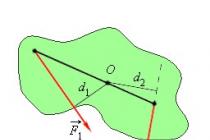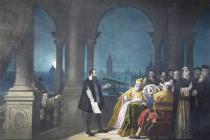An extremely interesting and not yet fully understood process of energy production by green plants today is as follows. A quantum of light, absorbed by a chlorophyll molecule, imparts energy to its electrons, which are transferred to excited levels. From there, they travel through other molecules linked to chlorophyll into a single chain of energy generation. If there was no such “commonwealth”, then the electrons raised to high energy levels would simply fall to their former places, and the absorbed energy would dissipate. In other words, the molecule would emit a quantum of energy without doing any chemical work. It would be about the same as what happens when a steel ball bounces. He falls without doing almost any work, except perhaps to overcome the friction of the air and hit the ground. It would be a different matter if the ball, bouncing, for example, would close an electric circuit, thereby forcing the light bulb to light. Here, too, some fraction of the energy would be lost, but useful work would be done, although the ball would eventually return to its original state.
Something similar happens with the excited electrons of the chlorophyll molecule. Having used up the excess of energy imparted to them by the quantum of light, they return to their previous levels. To whom do the excited electrons transfer their energy? To our good friends - cytochromes, which produce the main energy currency of the body - ATP. Note that the photosynthetic relay race for the transfer of light quantum energy occurs with a very high efficiency, approximately 97%, and the entire process of photosynthesis takes place useful work slightly less than 30%.
We have given these figures for a reason. The production of ATP by the cell is amazingly perfect. Per unit of mass; the living entity produces much more energy than the sun. It is curious that a person weighing 70 kg produces up to 75 kg of ATP per day, that is, more than his own weight! The same amount of ATF, produced by the industry for technical needs, costs no less than 150 thousand dollars.
Energy production is, so to speak, one of the aspects of chlorophyll activity that does not go beyond the body. More impressive is the other side, characterized by the initial and final products of photosynthesis. As a result of this process, organic compounds and oxygen are formed from carbon dioxide and water under the influence of light. Thanks to chlorophyll, the Earth assimilates 200 billion tons of carbon dioxide annually, which gives 100 billion tons of organic matter and about 145 billion tons of free oxygen.
Today it is generally accepted that thanks to the photosynthesis of the first green organisms that appeared about three billion years ago, the modern atmosphere was formed and conditions for the formation of the biosphere appeared (we have already spoken about this above). These are the miracles that magnesium works in a porphyrin ring.
Studying a process like photosynthesis activated by light, it is important to determine the spectra of this process in order to identify the pigments involved. The spectrum of action is a graph showing the dependence of the efficiency of the studied process on exposure to light with different wavelengths.
Absorption spectrum is a graph showing the relative amount of light absorbed by a pigment at different wavelengths. The figure shows spectrum of photosynthesis and absorption spectrum for combined photosynthetic pigments.
Pay attention to the great similarity of the graphs presented, which means that for the absorption of light at photosynthesis pigments are responsible, and chlorophyll in particular.
Excitation of chlorophyll by light
When the chlorophyll molecule or another photosynthetic pigment absorbs light, it is said to have gone into an agitated state. Light energy is used to transfer electrons to a higher energy level. The light energy is captured by chlorophyll and converted into chemical energy. The excited state of chlorophyll is unstable, and its molecules tend to return to their normal (stable) state. For example, if we pass light through a chlorophyll solution, and then observe it in the dark, we will see that the solution fluoresces. This is because excess excitation energy is converted to light with a longer wavelength (and less energy), with the remainder of the energy being lost as heat.
Excited electrons return to their normal low energy state. In a living plant, the released energy can be transferred to another chlorophyll molecule (see below). In this case, an excited electron can pass from a chlorophyll molecule to another molecule called an electron acceptor. Since the electron is negatively charged, after its "departure" a positively charged "hole" remains in the chlorophyll molecule.

The process of giving up electrons is called oxidation, and the process of their acquisition is restoration. Consequently, chlorophyll is oxidized and the electron acceptor is reduced. Chlorophyll replaces the lost electrons with low-energy electrons from other molecules called electron donors.
The first stages of the photosynthesis process includes the movement of both energy and excited electrons between molecules within the photosystems described below.
How is the conversion of the energy of sunlight in the light and dark phases of photosynthesis into the energy of chemical bonds of glucose? Explain the answer.
Answer
In the light phase of photosynthesis, the energy of sunlight is converted into energy of excited electrons, and then the energy of excited electrons is converted into energy of ATP and NADPH-H2. In the dark phase of photosynthesis, the energy of ATP and NADPH-H2 is converted into the energy of chemical bonds of glucose.
What happens during the light phase of photosynthesis?
Answer
Chlorophyll electrons, excited by the energy of light, go along electron transport chains, their energy is stored in ATP and NADP-H2. Photolysis of water occurs, oxygen is released.
What are the main processes occurring during the dark phase of photosynthesis?
Answer
From carbon dioxide obtained from the atmosphere and hydrogen obtained in the light phase, glucose is formed due to the energy of ATP obtained in the light phase.
What is the function of chlorophyll in a plant cell?
Answer
Chlorophyll participates in the process of photosynthesis: in the light phase, chlorophyll absorbs light, the chlorophyll electron receives light energy, breaks off and goes along the electron transport chain.
What role do electrons of chlorophyll molecules play in photosynthesis?
Answer
Chlorophyll electrons, excited by sunlight, pass through electron transport chains and give up their energy to the formation of ATP and NADPH-H2.
At what stage of photosynthesis is free oxygen formed?
Answer
In the light phase, during the photolysis of water.
In what phase of photosynthesis does ATP synthesis take place?
Answer
In the light phase.
What substance serves as a source of oxygen during photosynthesis?
Answer
Water (oxygen is released during photolysis of water).
The rate of photosynthesis depends on limiting (limiting) factors, among which light, carbon dioxide concentration, and temperature are emitted. Why are these factors limiting for photosynthetic reactions?
Answer
Light is necessary to excite chlorophyll, it supplies energy for the process of photosynthesis. Carbon dioxide is necessary in the dark phase of photosynthesis, glucose is synthesized from it. Temperature change leads to denaturation of enzymes, photosynthesis reactions slow down.
In what metabolic reactions in plants is carbon dioxide the initial substance for the synthesis of carbohydrates?
Answer
In the reactions of photosynthesis.
In the leaves of plants, the process of photosynthesis proceeds intensively. Does it occur in ripe and unripe fruits? Explain the answer.
Answer
Photosynthesis takes place in green parts of plants exposed to light. Thus, photosynthesis takes place in the skin of green fruits. Photosynthesis does not occur inside fruits and in the skin of ripe (not green) fruits.
The history of the study of photosynthesis dates back to August 1771, when the English theologian, philosopher and amateur naturalist Joseph Priestley (1733–1804) discovered that plants can "correct" the properties of air that changes its composition as a result of combustion or animal activity. Priestley showed that in the presence of plants, "tainted" air becomes again suitable for burning and supporting animal life.
In the course of further research by Ingenhaus, Senebier, Saussure, Boussingault and other scientists, it was found that plants, when illuminated, emit oxygen and absorb carbon dioxide from the air. Plants synthesize from carbon dioxide and water organic matter... This process has been called photosynthesis.
Robert Mayer, who discovered the law of conservation of energy, in 1845 suggested that plants convert the energy of sunlight into the energy of chemical compounds formed during photosynthesis. According to him, "the rays of the sun spreading in space are" captured "and stored for further use as needed." Subsequently, the Russian scientist K.A. Timiryazev convincingly proved that chlorophyll molecules present in green leaves play an important role in the use of sunlight energy by plants.
The carbohydrates (sugars) formed during photosynthesis are used as a source of energy and building material for the synthesis of various organic compounds in plants and animals. In higher plants, the processes of photosynthesis take place in chloroplasts - specialized energy-converting organelles of the plant cell.
A schematic representation of chloroplast is shown in Fig. 1.
Under the double shell of the chloroplast, which consists of outer and inner membranes, there are extended membrane structures that form closed vesicles called thylakoids. Thylakoid membranes consist of two layers of lipid molecules, which include macromolecular photosynthetic protein complexes. In chloroplasts of higher plants, thylakoids are grouped into granas, which are stacks of flattened and closely pressed thylakoids in the form of discs. The continuation of individual gran thylakoids is intergranular thylakoids protruding from them. The space between the chloroplast membrane and the thylakoids is called the stroma. The stroma contains chloroplast molecules RNA, DNA, ribosomes, starch grains, and numerous enzymes, including those that ensure the absorption of CO2 by plants.
This publication has been produced with the assistance of Sushi E'xpress. The Sushi E'xpress company provides sushi delivery services in Novosibirsk. By ordering sushi from the Sushi Express company, you will quickly receive a tasty and healthy dish made by professional chefs using the freshest ingredients of the highest quality. By visiting the website of the Sushi Express company, you can familiarize yourself with the prices and composition of the offered rolls, which will help you decide on the choice of the dish. To place an order for sushi delivery, call 239-55-87
Light and dark stages of photosynthesis
According to modern concepts, photosynthesis is a series of photophysical and biochemical processes, as a result of which plants, using the energy of sunlight, synthesize carbohydrates (sugars). Numerous stages of photosynthesis are usually divided into two large groups of processes - light and dark phases.
The light stages of photosynthesis is usually called a set of processes as a result of which, due to the energy of light, molecules of adenosine triphosphate (ATP) are synthesized and the formation of reduced nicotinamide adenine dinucleotide phosphate (NADPH), a compound with a high reduction potential, occurs. ATP molecules play the role of a universal source of energy in the cell. The energy of the high-energy (i.e. energy-rich) phosphate bonds of the ATP molecule is known to be used in most biochemical energy-consuming processes.
Light processes of photosynthesis take place in thylakoids, the membranes of which contain the main components of the photosynthetic apparatus of plants - light-harvesting pigment-protein and electron transport complexes, as well as an ATP-synthase complex, which catalyzes the formation of ATP from adenosine diphosphate (ADP) and inorganic phosphate (Phi) (ADP + Ф i → ATP + H 2 O). Thus, as a result of the light stages of photosynthesis, the energy of light absorbed by plants is stored in the form of high-energy chemical bonds of ATP molecules and a strong reducing agent NADPH, which are used for the synthesis of carbohydrates in the so-called dark stages of photosynthesis.
The dark stages of photosynthesis are usually called a set of biochemical reactions, as a result of which plants assimilate atmospheric carbon dioxide (CO 2) and form carbohydrates. The cycle of dark biochemical transformations leading to the synthesis of organic compounds from CO 2 and water, named after the authors who made a decisive contribution to the study of these processes, is called the Calvin – Benson cycle. Unlike the electron transport and ATP synthase complexes, which are located in the thylakoid membrane, the enzymes that catalyze the "dark" reactions of photosynthesis are dissolved in the stroma. When the chloroplast membrane is destroyed, these enzymes are washed out from the stroma, as a result of which chloroplasts lose their ability to assimilate carbon dioxide.
As a result of transformations of a number of organic compounds in the Calvin – Benson cycle, from three molecules of CO 2 and water in chloroplasts, a molecule of glyceraldehyde-3-phosphate is formed, which has the chemical formula CHO – CHOH – CH 2 O – PO 3 2-. In this case, per CO 2 molecule included in glyceraldehyde-3-phosphate, three ATP molecules and two NADPH H molecules are consumed.
For the synthesis of organic compounds in the Calvin-Benson cycle, the energy released during the hydrolysis of the high-energy phosphate bonds of ATP molecules (reaction ATP + H 2 O → ADP + Phi) and the strong reduction potential of NADP H molecules are used. The main part of the molecules formed in the chloroplast glyceraldehyde-3-phosphate enters the cytosol of the plant cell, where it is converted into fructose-6-phosphate and glucose-6-phosphate, which in the course of further transformations form sugar phosphate, a precursor of sucrose. Starch is synthesized from the glyceraldehyde-3-phosphate molecules remaining in the chloroplast.
Energy conversion in photosynthetic reaction centers
Photosynthetic energy-converting complexes of plants, algae, and photosynthetic bacteria have been well studied. Installed chemical composition and the spatial structure of energy-converting protein complexes, the sequence of energy transformation processes has been clarified. Despite the differences in the composition and molecular structure of the photosynthetic apparatus, there are general patterns energy conversion processes in photoreaction centers of all photosynthetic organisms. In photosynthetic systems of both plant and bacterial origin, a single structural and functional link of the photosynthetic apparatus is photosystem, which includes a light-collecting antenna, a photochemical reaction center and associated molecules - electron carriers.
Let us first consider the general principles of the conversion of sunlight energy, which are characteristic of all photosynthetic systems, and then dwell in more detail on the example of the functioning of photoreaction centers and the electron transport chain of chloroplasts in higher plants.
Light-collecting antenna (light absorption, energy migration to the reaction center)
The very first elementary act of photosynthesis is the absorption of light by chlorophyll molecules or auxiliary pigments that make up a special pigment-protein complex called a light-harvesting antenna. The light-collecting antenna is a macromolecular complex designed to efficiently capture light. In chloroplasts, the antenna complex contains a large number (up to several hundred) of chlorophyll molecules and a certain amount of auxiliary pigments (carotenoids) tightly bound to the protein.
In bright sunlight, a single chlorophyll molecule absorbs light quanta relatively rarely, on average no more than 10 times per second. However, since one photoreaction center contains a large number of chlorophyll molecules (200–400), even with a relatively low intensity of light falling on a leaf under conditions of plant shading, the reaction center is often triggered. The ensemble of pigments that absorb light, in fact, acts as an antenna, which, due to its sufficiently large size, effectively captures sunlight and directs its energy to the reaction center. Shade-loving plants usually have a larger light-harvesting antenna than plants growing in high light conditions.
In plants, the main light-harvesting pigments are chlorophyll molecules a and chlorophyll b that absorb visible light with a wavelength λ ≤ 700-730 nm. Isolated chlorophyll molecules absorb light only in two relatively narrow bands of the solar spectrum: at wavelengths of 660-680 nm (red light) and 430-450 nm (blue-violet light), which, of course, limits the efficiency of using the entire spectrum of incident sunlight on a green leaf.
However, the spectral composition of the light absorbed by the light-collecting antenna is actually much wider. This is explained by the fact that the absorption spectrum of the aggregated forms of chlorophyll included in the light-harvesting antenna is shifted towards longer wavelengths. Along with chlorophyll, auxiliary pigments are included in the light-harvesting antenna, which increase the efficiency of its operation due to the fact that they absorb light in those regions of the spectrum in which chlorophyll molecules, the main pigment of the light-harvesting antenna, absorb light relatively weakly.
In plants, auxiliary pigments are carotenoids that absorb light in the wavelength range λ ≈ 450–480 nm; in the cells of photosynthetic algae these are red and blue pigments: phycoerythrins in red algae (λ ≈ 495–565 nm) and phycocyanins in blue-green algae (λ ≈ 550–615 nm).
The absorption of a quantum of light by a chlorophyll (Chl) molecule or an auxiliary pigment leads to its excitation (the electron goes to a higher energy level):
Chl + hν → Chl *.
The energy of the excited chlorophyll molecule Chl * is transferred to molecules of neighboring pigments, which, in turn, can transfer it to other molecules of the light-harvesting antenna:
Chl * + Chl → Chl + Chl *.
 The excitation energy can thus migrate along the pigment matrix until the excitation eventually reaches the photoreaction center P (a schematic representation of this process is shown in Fig. 2):
The excitation energy can thus migrate along the pigment matrix until the excitation eventually reaches the photoreaction center P (a schematic representation of this process is shown in Fig. 2):
Chl * + P → Chl + P *.
Note that the duration of the existence of chlorophyll molecules and other pigments in an excited state is very short, τ ≈ 10 –10 –10 –9 s. Therefore, there is a certain probability that on the way to the reaction center P, the energy of such short-lived excited states of pigments can be uselessly lost - scattered into heat or released as a quantum of light (fluorescence phenomenon). In reality, however, the efficiency of energy migration to the photosynthetic reaction center is very high. In the case when the reaction center is in an active state, the probability of energy loss is, as a rule, no more than 10–15%. This high efficiency in the use of energy from sunlight is due to the fact that the light-harvesting antenna is a highly ordered structure that provides very good interaction of pigments with each other. Due to this, a high rate of transfer of excitation energy from molecules that absorb light to the photoreaction center is achieved. The average time for the “jump” of the excitation energy from one pigment to another, as a rule, is τ ≈ 10 –12 –10 –11 s. The total time of migration of excitation to the reaction center usually does not exceed 10 –10 –10 –9 s.
Photochemical reaction center (electron transfer, stabilization of separated charges)
The modern concepts of the structure of the reaction center and the mechanisms of the primary stages of photosynthesis were preceded by the work of A.A. Krasnovsky, who discovered that in the presence of electron donors and acceptors, chlorophyll molecules excited by light are capable of reversibly reducing (accepting an electron) and oxidizing (donating an electron). Subsequently, Cock, Witt and Duisens discovered in plants, algae and photosynthetic bacteria special pigments of a chlorophyll nature, called reaction centers, which are oxidized when exposed to light and are, in fact, the primary electron donors during photosynthesis.
The photochemical reaction center P is a special pair (dimer) of chlorophyll molecules that act as a trap for excitation energy wandering along the pigment matrix of the light-harvesting antenna (Fig. 2). Just as the liquid flows from the walls of a wide funnel to its narrow neck, the energy of light absorbed by all the pigments of the light-collecting antenna is directed to the reaction center. Excitation of the reaction center initiates a chain of further transformations of light energy during photosynthesis.
The sequence of processes occurring after the excitation of the reaction center P and the diagram of the corresponding changes in the energy of the photosystem are schematically shown in Fig. 3.
Along with the chlorophyll P dimer, the photosynthetic complex includes molecules of primary and secondary electron acceptors, which we conventionally denote by the symbols A and B, as well as the primary electron donor, molecule D. The excited reaction center P * has a low electron affinity and therefore it easily gives to its next to it primary electron acceptor A:
D (P * A) B → D (P + A -) B.
Thus, as a result of a very fast (t ≈10 –12 s) electron transfer from P * to A, the second fundamentally important stage in the conversion of solar energy during photosynthesis is realized - charge separation in the reaction center. In this case, a strong reducing agent A - (electron donor) and a strong oxidizing agent P + (electron acceptor) are formed.
Molecules P + and A - are located in the membrane asymmetrically: in chloroplasts, the reaction center P + is closer to the membrane surface facing the inside of the thylakoid, and acceptor A is located closer to the outer side. Therefore, as a result of photoinduced separation of charges on the membrane, an electrical potential difference arises. Light-induced charge separation in the reaction center is similar to the generation of an electrical potential difference in a conventional photocell. However, it should be emphasized that, in contrast to all known and widely used photoconverters of energy in technology, the efficiency of photosynthetic reaction centers is very high. The efficiency of charge separation in active photosynthetic reaction centers, as a rule, exceeds 90–95% (for the best samples of photocells, the efficiency is no more than 30%).
What mechanisms provide such a high efficiency of energy conversion in reaction centers? Why does the electron transferred to the acceptor A not return back to the positively charged oxidized center P +? Stabilization of separated charges is provided mainly due to secondary processes of electron transport following the transfer of an electron from P * to A. From the reduced primary acceptor A - the electron very quickly (in 10 –10 –10 –9 s) leaves to the secondary electron acceptor B:
D (P + A -) B → D (P + A) B -.
In this case, not only the removal of an electron from the positively charged reaction center P + occurs, but also the energy of the entire system is noticeably reduced (Fig. 3). This means that in order to transfer an electron in the opposite direction (transition B - → A), it will need to overcome a sufficiently high energy barrier ΔE ≈ 0.3–0.4 eV, where ΔE is the difference in energy levels for two states of the system in which the electron is located respectively on the carrier A or B. For this reason, to return the electron back, from the reduced molecule B - to the oxidized molecule A, it would take much longer than for the direct transition A - → B. In other words, in the forward direction, the electron is transferred much faster than the other way around. Therefore, after the transfer of an electron to the secondary acceptor B, the probability of its return back and recombination with a positively charged "hole" P + significantly decreases.
The second factor contributing to the stabilization of separated charges is the rapid neutralization of the oxidized photoreaction center P + due to the electron coming to P + from the electron donor D:
D (P + A) B - → D + (PA) B -.
Having received an electron from the donor molecule D and having returned to its original reduced state P, the reaction center will no longer be able to accept an electron from the reduced acceptors, but now it is ready to trigger again - to donate an electron to the adjacent oxidized primary acceptor A. This is the sequence of events that occur in photoreaction centers of all photosynthetic systems.
Chloroplast electronic transport chain
In chloroplasts of higher plants, there are two photosystems: photosystem 1 (PS1) and photosystem 2 (PS2), which differ in the composition of proteins, pigments, and optical properties. The light-collecting antenna FS1 absorbs light with a wavelength λ ≤ 700–730 nm, and FS2 - light with λ ≤ 680–700 nm. Light-induced oxidation of the PS1 and PS2 reaction centers is accompanied by their discoloration, which is characterized by changes in their absorption spectra at λ ≈ 700 and 680 nm. In accordance with their optical characteristics, the PS1 and PS2 reaction centers were named P 700 and P 680.
The two photosystems are interconnected by means of a chain of electronic carriers (Fig. 4). PS2 is a source of electrons for PS1. The light-initiated charge separation in the photoreaction centers P 700 and P 680 ensures the transfer of an electron from water decomposed in PS2 to the final electron acceptor, the NADP + molecule. The electron transport chain (ETC), which connects the two photosystems, as electron carriers includes plastoquinone molecules, a separate electron transport protein complex (the so-called b / f-complex), and a water-soluble plastocyanin protein (P c). Diagram illustrating mutual arrangement electron transport complexes in the thylakoid membrane and the path of electron transfer from water to NADP + is shown in Fig. 4.
In PS2, from the excited center P * 680, an electron is first transferred to the primary acceptor pheofetin (Phe), and then to the plastoquinone molecule Q A, which is tightly bound to one of the PS2 proteins,
Y (P * 680 Phe) Q A Q B → Y (P + 680 Phe -) Q A Q B → Y (P + 680 Phe) Q A - Q B.
Then an electron is transferred to the second plastoquinone molecule Q B, and P 680 receives an electron from the primary electron donor Y:
Y (P + 680 Phe) Q A - Q B → Y + (P 680 Phe) Q A Q B -.
 A plastoquinone molecule, the chemical formula of which and its location in the lipid bilayer membrane are shown in Fig. 5 is capable of accepting two electrons. After two-fold activation of the PS2 reaction center, the plastoquinone molecule Q B will receive two electrons:
A plastoquinone molecule, the chemical formula of which and its location in the lipid bilayer membrane are shown in Fig. 5 is capable of accepting two electrons. After two-fold activation of the PS2 reaction center, the plastoquinone molecule Q B will receive two electrons:
Q B + 2е - → Q B 2–.
The negatively charged molecule Q B 2– has a high affinity for hydrogen ions, which it captures from the stromal space. After protonation of the reduced plastoquinone Q B 2– (Q B 2– + 2H + → QH 2), an electrically neutral form of this QH 2 molecule is formed, which is called plastoquinol (Fig. 5). Plastoquinol acts as a mobile carrier of two electrons and two protons: after leaving PS2, the QH2 molecule can easily move inside the thylakoid membrane, providing PS2 with other electron transport complexes.
The oxidized PS2 P 680 reaction center has an exceptionally high electron affinity; is a very strong oxidizing agent. Due to this, water decomposition occurs in PS2 - chemically stable connection... The water-cleaving complex (WSC) included in PS2 contains in its active center a group of manganese ions (Mn 2+), which serve as electron donors for P 680. By donating electrons to the oxidized reaction center, manganese ions become "accumulators" of positive charges, which are directly involved in the water oxidation reaction. As a result of the sequential fourfold actuation of the P 680 reaction center, four strong oxidative equivalents (or four “holes”) accumulate in the Mn-containing active center of the P680 in the form of oxidized manganese ions (Mn 4+), which, interacting with two water molecules, catalyze the decomposition reaction water:
2Mn 4+ + 2H 2 O → 2Mn 2+ + 4H + + O 2.
Thus, after the sequential transfer of four electrons from the RPC to P 680, two water molecules simultaneously decompose, accompanied by the release of one oxygen molecule and four hydrogen ions, which enter the intrathylakoid space of the chloroplast.
The plastoquinol QH 2 molecule formed during PS2 functioning diffuses into the lipid bilayer of the thylakoid membrane to the b / f-complex (Figs. 4 and 5). Upon collision with the b / f complex, the QH 2 molecule binds to it and then transfers two electrons to it. In this case, for each plastoquinol molecule oxidized by the b / f-complex, two hydrogen ions are released into the thylakoid. In turn, the b / f-complex serves as an electron donor for plastocyanin (P c), a relatively small water-soluble protein in which the active center contains a copper ion (the reduction and oxidation reactions of plastocyanin are accompanied by changes in the valence of the copper ion Cu 2+ + e - ↔ Cu +). Plastocyanin acts as a link between the b / f complex and PS1. The plastocyanin molecule quickly moves inside the thylakoid, providing electron transfer from the b / f complex to PS1. From the reduced plastocyanin, an electron goes directly to the oxidized reaction centers PS1 - P 700 + (see Fig. 4). Thus, as a result of the combined action of PS1 and PS2, two electrons from the water molecule decomposed in PS2 are ultimately transferred through the electron transport chain to the NADP + molecule, providing the formation of a strong reducing agent NADPH.
Why do chloroplasts need two photosystems? It is known that photosynthetic bacteria, which use various organic and inorganic compounds(for example, H 2 S), successfully operate with one photo system. The appearance of two photosystems is most likely due to the fact that the energies of one quantum visible light insufficient to ensure the decomposition of water and the effective passage of an electron all the way along the chain of carrier molecules from water to NADP +. About 3 billion years ago, blue-green algae or cyanobacteria appeared on Earth, which acquired the ability to use water as a source of electrons to reduce carbon dioxide. Currently, it is believed that PS1 is derived from green bacteria, and PS2 from purple bacteria. After during the evolutionary process PS2 was “included” in a single electron transfer chain together with PS1, it became possible to solve the energy problem - to overcome a rather large difference in the redox potentials of oxygen / water and NADP + / NADPH pairs. The emergence of photosynthetic organisms, capable of oxidizing water, has become one of the most important stages in the development of wildlife on Earth. First, algae and green plants, having "learned" to oxidize water, have taken possession of an inexhaustible source of electrons for the reduction of NADP +. Secondly, decomposing water, they filled the Earth's atmosphere with molecular oxygen, thus creating conditions for the rapid evolutionary development of organisms, the energy of which is associated with aerobic respiration.
Coupling of electron transport processes with proton transfer and ATP synthesis in chloroplasts
The transfer of an electron along the CET is, as a rule, accompanied by a decrease in energy. This process can be likened to the spontaneous movement of the body along an inclined plane. A decrease in the energy level of an electron in the course of its movement along the CET does not mean at all that the transfer of an electron is always an energetically useless process. Under normal conditions of chloroplast functioning, most of the energy released during electron transport is not wasted uselessly, but is used to operate a special energy-converting complex called ATP synthase. This complex catalyzes the energetically unfavorable process of ATP formation from ADP and inorganic phosphate Ф i (reaction ADP + Ф i → ATP + H 2 O). In this regard, it is customary to say that energy-donating processes of electronic transport are associated with energy-accepting processes of ATP synthesis.
Proton transport processes play an important role in ensuring energy conjugation in thylakoid membranes, as in all other energy-converting organelles (mitochondria, chromatophores of photosynthetic bacteria). ATP synthesis is closely related to the transfer through ATP synthase of three protons from thylakoids (3H in +) to the stroma (3H out +):
ADP + Ph i + 3H in + → ATP + H 2 O + 3H out +.
This process becomes possible because, due to the asymmetric arrangement of carriers in the membrane, the functioning of chloroplast CET leads to the accumulation of an excess amount of protons inside the thylakoid: hydrogen ions are absorbed from the outside at the stages of NADP + reduction and plastoquinol formation and are released inside thylakoids at the stages of water decomposition and plastoquinol oxidation (Fig. . 4). Illumination of chloroplasts leads to a significant (100–1000 times) increase in the concentration of hydrogen ions inside thylakoids.
So, we examined a chain of events during which the energy of sunlight is stored in the form of energy of high-energy chemical compounds - ATP and NADPH. These products of the light stage of photosynthesis are used in the dark stages to form organic compounds (carbohydrates) from carbon dioxide and water. The main stages of energy conversion, leading to the formation of ATP and NADPH, include the following processes: 1) absorption of light energy by pigments of the light-collecting antenna; 2) transfer of excitation energy to the photoreaction center; 3) oxidation of the photoreaction center and stabilization of separated charges; 4) electron transfer along the electron transport chain, the formation of NADPH; 5) transmembrane transport of hydrogen ions; 6) synthesis of ATP.
1. Alberts B., Bray D., Lewis J., Roberts K., Watson J. Molecular biology cells. T. 1. - M .: Mir, 1994.2nd ed.
2. Kukushkin A.K., Tikhonov A.N. Lectures on biophysics of plant photosynthesis. - M .: Publishing house of Moscow State University, 1988.
3. Nichols D.D. Bioenergy. Introduction to Chemiosmotic Theory. - M .: Mir, 1985.
4. Skulachev V.P. Energy of biological membranes. - M .: Nauka, 1989.














